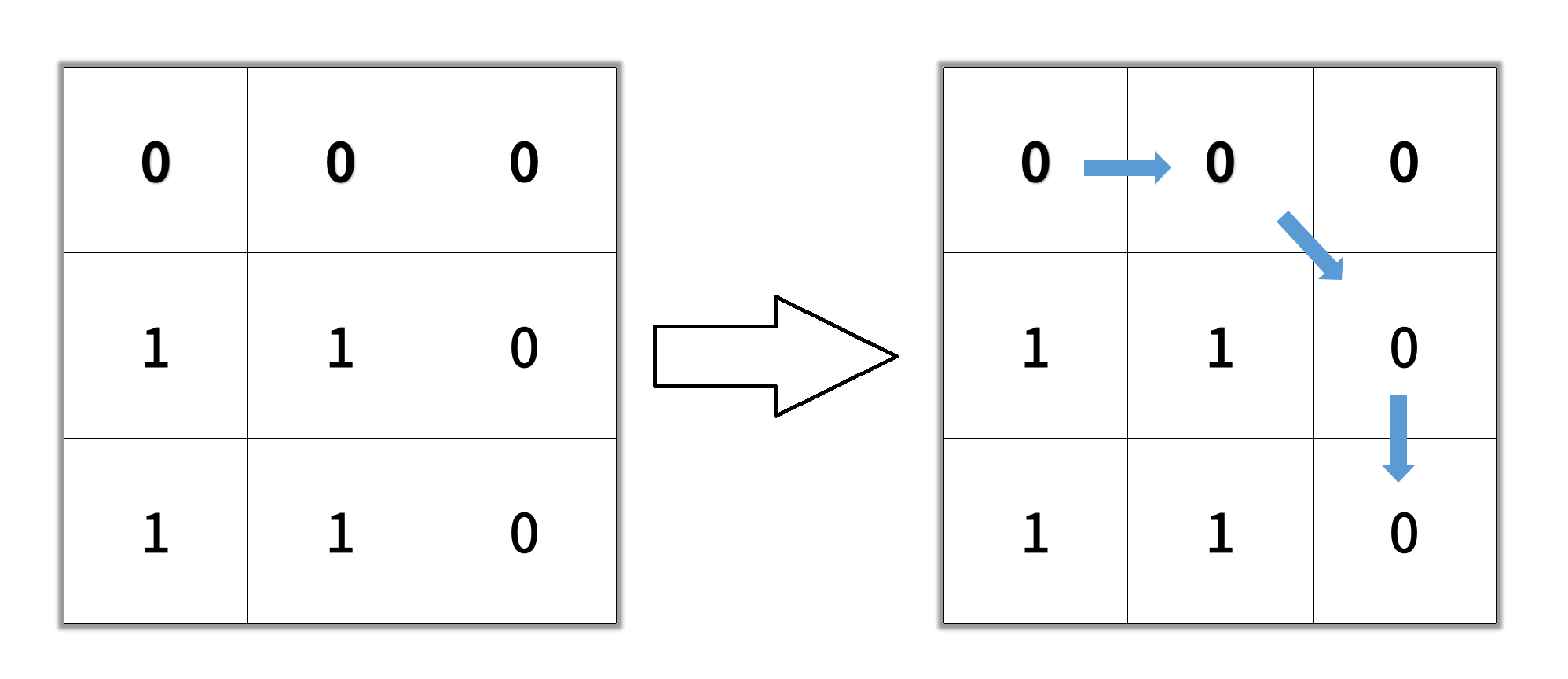Shortest Path in Binary Matrix
Given an n x n binary matrix grid, return the length of the shortest clear path in the matrix. If there is no clear path, return -1.
A clear path in a binary matrix is a path from the top-left cell (i.e., (0, 0)) to the bottom-right cell (i.e., (n - 1, n - 1)) such that:
- All the visited cells of the path are
0. - All the adjacent cells of the path are 8-directionally connected (i.e., they are different and they share an edge or a corner).
The length of a clear path is the number of visited cells of this path.
Example 1:

Input: grid = [[0,1],[1,0]]
Output: 2
Example 2:

Input: grid = [[0,0,0],[1,1,0],[1,1,0]]
Output: 4
Example 3:
Input: grid = [[1,0,0],[1,1,0],[1,1,0]]
Output: -1
Constraints:
n == grid.lengthn == grid[i].length1 <= n <= 100grid[i][j] is 0 or 1
Solution
To find the shortest clear path from (0,0) to (n-1, n-1), we will perform breadth first search from (0,0).
First, we need to make sure that grid[0][0] is 0, otherwise a clear path does not exist.
Each cell has (at most) 8 neighbours, and we can use the get_neighbours function to find the neighbours.
Then, we will only continue on cells labeled 0, the number of levels of the BFS traversal is the length of the shortest clear path.
Implementation
def shortestPathBinaryMatrix(self, grid: List[List[int]]) -> int:
if grid[0][0] == 1: return -1
n = len(grid)
dirs = [(-1, -1), (-1, 0), (-1, 1), (0, -1), (0, 1), (1, -1), (1, 0), (1, 1)]
def get_neighbours(x, y):
neighbours = []
for dx, dy in dirs:
if 0 <= x+dx < n and 0 <= y+dy < n:
neighbours.append((x+dx, y+dy))
return neighbours
length = 1
q = deque()
q.append((0,0))
unvisited = [[True for _ in range(n)] for _ in range(n)]
unvisited[0][0] = False
while q:
count = len(q)
for _ in range(count):
x, y = q.popleft()
if x == n -1 and y == n-1:
return length
for nx, ny in get_neighbours(x, y):
if grid[nx][ny] == 0 and unvisited[nx][ny]:
q.append((nx, ny))
unvisited[nx][ny] = False
length += 1
return -1
Ready to land your dream job?
Unlock your dream job with a 5-minute evaluator for a personalized learning plan!
Start EvaluatorA person thinks of a number between 1 and 1000. You may ask any number questions to them, provided that the question can be answered with either "yes" or "no".
What is the minimum number of questions you needed to ask so that you are guaranteed to know the number that the person is thinking?
Recommended Readings
Coding Interview Patterns Your Personal Dijkstra's Algorithm to Landing Your Dream Job The goal of AlgoMonster is to help you get a job in the shortest amount of time possible in a data driven way We compiled datasets of tech interview problems and broke them down by patterns This way
Recursion If you prefer videos here's a video that explains recursion in a fun and easy way Recursion is one of the most important concepts in computer science Simply speaking recursion is the process of a function calling itself Using a real life analogy imagine a scenario where you invite your friends to lunch https assets algo monster recursion jpg You first call Ben and ask him
Runtime Overview When learning about algorithms and data structures you'll frequently encounter the term time complexity This concept is fundamental in computer science and offers insights into how long an algorithm takes to complete given a certain input size What is Time Complexity Time complexity represents the amount of time
Want a Structured Path to Master System Design Too? Don’t Miss This!
